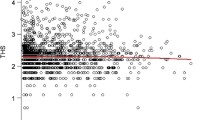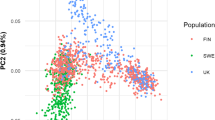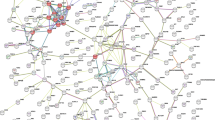Abstract
Canine hip dysplasia (CHD) is a common hereditary developmental disease of the coxofemoral joints. CHD is characterized by subluxation of the femoral head and deformation of the acetabulum leading to a painful osteoarthrosis. Analyses of mode of inheritance have shown the involvement of a major gene in expression of CHD in German Shepherd dogs. Thus, a whole genome scan for quantitative trait loci (QTL) was performed in German Shepherd dogs. For this purpose 11 paternal half-sib families, including a total of 459 purebred German Shepherd dogs with sires, dams, and offspring, were genotyped for 261 microsatellites. These markers were equidistantly distributed over all 38 autosomes and the X chromosome with an average marker distance of 11.7 cM. The mean observed heterozygosity of the marker set was 50%. The CHD status for the dogs was scored according to the official rules of the Fédération Cynologique Internationale. At the genome-wide level of significance at p < 0.05, QTL for CHD were located on nine different canine chromosomes: 1, 3, 4, 8, 9, 16, 19, 26, and 33. The minimal QTL regions containing the CHD genes spanned on average 5 Mb with a range between 1 and 8.2 Mb. Chromosome-wide level of significance at p < 0.05 was found for QTL on 19 chromosomes. Further analyses can now be performed to refine these map positions of QTL already identified in German Shepherd dogs.









Similar content being viewed by others
References
Abecasis GR, Wigginton JE (2005) Handling marker–marker linkage disequilibrium: pedigree analysis with clustered markers. Am J Hum Genet 77:754–767
Abecasis GR, Cherny SS, Cookson WO, Cardon LR (2002) Merlin – rapid analysis of dense genetic maps using sparse gene flow trees. Nat Genet 30:97–101
Brass W (1989) Hip dysplasia in dogs. J Small Anim Pract 30:166–170
Brass W (1993) Hüftgelenkdysplasie und Ellenbogenerkrankung im Visier der Fédération Cynologique Internationale I. Kleintier-Prax 38:194
Chase K, Lawler DF, Adler FR, Ostrander EA, Lark KG (2004) Bilaterally asymmetric effects of quantitative trait loci (QTLs): QTLs that affect laxity in the right versus left coxofemoral (hip) joints of the dog (Canis familiaris). Am J Med Genet 124:239–247
Chase K, Lawler DF, Carrier DR, Lark KG (2005) Genetic regulation of osteoarthritis: A QTL regulating cranial and caudal acetabular osteophyte formation in the hip joint of the dog (Canis familiaris). Am J Med Genet 135:334–335
Fingerlin TE, Boehnke M, Abecasis GR (2004) Increasing the power and efficiency of disease marker case-control association studies through use of allele-sharing information. Am J Hum Genet 74:432–443
Flückiger MA, Friedrich GA, Binder H (1998) Correlation between hip joint laxity and subsequent coxarthrosis in dogs. J Vet Med A 45:199–207
Frost-Christensen LN, Voorhout G, van den Brom WE, van den Broek J, Hazewinkel HAW (2002) The value of clinical and radiological evaluations to diagnose and predict hip dysplasia in young Labradors. Proc European College of Veterinary Surgeons, Vienna, pp 202–383
Guyon R, Lorentzen TD, Hitte C, Kim L, Cadieu E, et al. (2003) A 1-Mb resolution radiation hybrid map of the canine genome. Proc Natl Acad Sci U S A 100:5296–5301
Hamann H, Kirchhoff T, Distl O (2003) Bayesian analysis of heritability of canine hip dysplasia in German Shepherd Dogs. J Anim Breed Genet 120:258–268
Hedhammar A, Olsson SE, Andersson SA, Persson L, Pettersson L, et al. (1979) Canine hip dysplasia: study of heritability in 401 litters of German shepherd dogs. J Am Vet Med Assoc 174:1012–1016
Henricson B, Norberg I, Olsson SE (1966) On the etiology and pathogenesis of hip dysplasia: a comparative review. J Small Anim Pract 7:673–688
Henricson B, Ljunggren G, Olsson SE (1972) Canine hip dysplasia in Sweden. Incidence and genetics. Acta Radiol Suppl 319:175–180
Ingvarsson T, Stefansson SE, Gulcher JR, Jonsson HH, Jonsson H, et al. (2001) A large Icelandic family with early osteoarthritis of the hip associated with a susceptibility locus on chromosome 16p. Arthritis Rheum 44:2548–2555
Janutta V, Distl O (2006) Inheritance of canine hip dysplasia: review of estimation methods and of heritability estimates and prospects on further developments. Dtsch tierärztl Wochenschr 113:6–12
Janutta V, Hamann H, Distl O (2006) Complex segregation analysis of canine hip dysplasia in German shepherd dogs. J Hered 97:13–20
Kong A, Cox J (1997) Allele-sharing models: LOD scores and accurate linkage tests. Am J Hum Genet 61:1179–88
Leighton EA (1997) Genetics of canine hip dysplasia. J Am Vet Med Assoc 210:1474–1479
Leppänen M, Maki K, Juga J, Saloniemi H (2000) Factors affecting hip dysplasia in German shepherd dogs in Finland: efficacy of the current improvement programme. J Small Anim Pract 41:19–23
Lingaas F, Heim P (1987) En genetisk undersøkelse av hofteleddsdysplasi i norske hunderaser. Norsk Veterinærtidsskr 99:617–623
Loughlin J, Mustafa Z, Dowling B, Southam L, Marcelline L, et al. (2002) Finer linkage mapping of a primary hip osteoarthritis susceptibility locus on chromosome 6. Eur J Hum Genet 10:562–568
Lust G, Williams AJ, Burton-Wurster N, Pijanowski GJ, Beck KA, et al. (1993) Joint laxity and its association with hip dysplasia in Labrador retrievers. Am J Vet Res 54:1990–1999
Mabuchi A, Nakamura S, Takatori Y, Ikegawa S (2006) Familial osteoarthritis of the hip joint associated with acetabular dysplasia maps to chromosome 13q. Am J Hum Genet 79:163–168
Madsen JS, Reimann I, Svalastoga E (1991) Delayed ossification of the femoral head in dogs with hip dysplasia. J Small Anim Pract 32:351–354
Mäki K, Janss LLG, Groen AF, Liinamo AE, Ojala M (2004) An indication of major genes affecting hip and elbow dysplasia in four Finnish dog populations. Heredity 92:402–408
Richman M, Mellersh CS, André C, Galibert F, Ostrander EA (2001) Characterization of a minimal screening set of 172 microsatellite markers for genome-wide screens of the canine genome. J Biochem Biophys Methods 47:137–149
Sargan DR, Aquirre-Hernandez J, Galibert F, Ostrander EA (2007) An extended microsatellite set for linkage mapping in the domestic dog. J Hered 98:221–231
Riser WH (1975) The dog as a model for the study of hip dysplasia. (Basel: Karger)
Roby P, Eyre S, Worthington J, Ramesar R, Cilliers H, et al. (1999) Autosomal dominant (Beukes) premature degenerative osteoarthropathy of the hip joint maps to an 11-cM region on chromosome 4q35. Am J Hum Genet 64:904–908
Smith GK, Gregor TP, Rhodes WH, Biery DN (1993) Coxofemoral joint laxity from distraction radiography and its contemporaneous and prospective correlation with laxity, subjective score, and evidence of degenerative joint disease from conventional hip-extended radiography in dogs. Am J Vet Res 54:1021–1042
Todhunter RJ, Zachos TA, Gilbert RO, Erb HN, Williams AJ, et al. (1997) Onset of epiphyseal mineralization and growth plate closure in radiographically normal and dysplastic Labrador retrievers. J Am Vet Med Assoc 210:1458–1462
Todhunter RJ, Acland GM, Olivier M, Williams AJ, Vernier-Singer M, et al. (1999) An outcrossed canine pedigree for linkage analysis of hip dysplasia. J Hered 90:83–92
Todhunter RJ, Mateescu R, Lust G, Burton-Wurster NI, Dykes NL, et al. (2005) Quantitative trait loci for hip dysplasia in a crossbreed canine pedigree. Mamm Genome 16:720–730
Vezzoni A, Dravelli G, Cobari A, De Lorenzi M, Cirla A, et al. (2005) Early diagnosis of canine hip dysplasia. Eur J Comp Anim Pract 15:173–184
Vitale MG, Skaggs DL (2001) Developmental dysplasia of the hip from six months to four years of age. J Am Acad Orthop Surg 9:401–411
Acknowledgments
This study and Yvonne Marschall were supported by the Gesellschaft zur Förderung Kynologischer Forschung e.V. (GKF), Bonn, and the Breeding Associaton of German Shepherd Dogs (Verein für Deutsche Schäferhunde e.V., SV), Augsburg. The authors are indebted to SV and Mr. Lux, managing director of the SV, for providing the data set, X rays, the official CHD scores, and blood samples. The authors are grateful to Stefan Neander for expert technical assistance.
Author information
Authors and Affiliations
Corresponding author
Electronic supplementary material
Rights and permissions
About this article
Cite this article
Marschall, Y., Distl, O. Mapping quantitative trait loci for canine hip dysplasia in German Shepherd dogs. Mamm Genome 18, 861–870 (2007). https://doi.org/10.1007/s00335-007-9071-z
Received:
Accepted:
Published:
Issue Date:
DOI: https://doi.org/10.1007/s00335-007-9071-z




